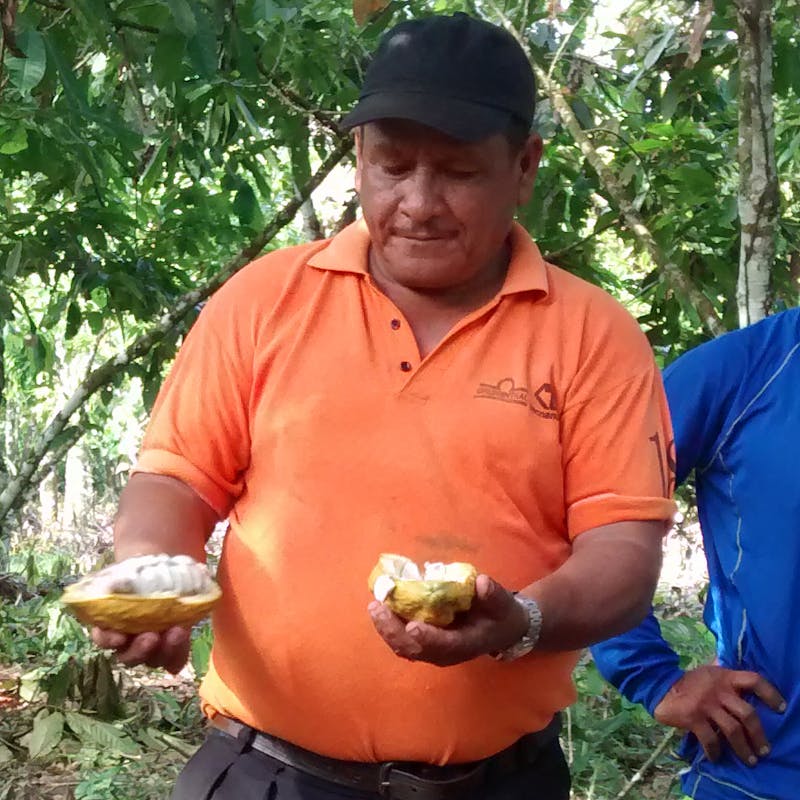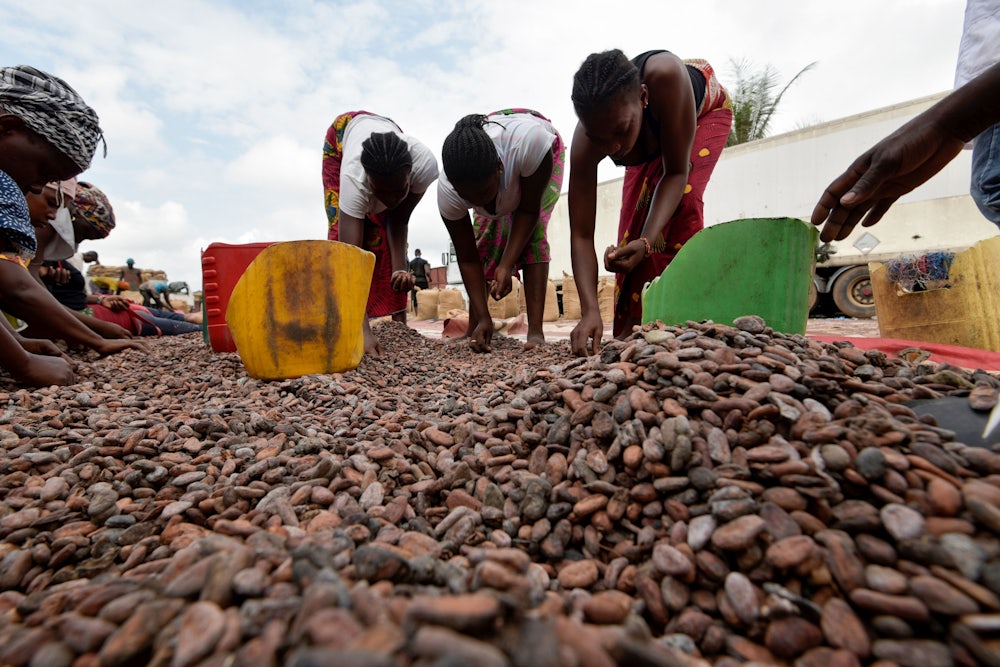The long black pruning poles looked cumbersome. But the farmers moved quickly, swarming over the small plot of land and hoisting the poles up to slice through cacao branches with ease. On the bottom end of the pole was a small gasoline engine; on the top, a chain saw. Buzzing sounds mixed with the humming of insects echoing through this corner of the Ecuadorian Amazon. Though it was early spring, the October heat already felt solid and oppressive as the workers, in jeans, long-sleeved orange tops, hard hats, and plastic face shields, strode through the jungle, chickens scrambling to get out of their way.
Farmers in this community were skeptical at first, but pruning the branches at the start of the season can increase the cocoa yield—sometimes dramatically. The tree produces more fruit on the branches that remain. “Also, by taking away unproductive branches, we limit or eliminate plagues or diseases,” Ricardo Zapata, a coordinator for the cacao-pruning initiative in Ecuador, told me. It’s one of several innovations experts say could make an infamously environmentally destructive crop more sustainable.
Chocolate has gotten a bad rap for its environmental impacts—particularly deforestation, as farmers cut down older trees in order to clear room for cacao plants. The Ivory Coast, which is the largest exporter of cocoa at 2.2 million tons every year, has lost 80 percent of its forests in the past five decades. And the forests being cleared for cacao farming are exactly the ones that tend to be the best carbon sinks and sources of biodiversity: Cacao trees thrive in rain forests, where there’s plenty of humidity and rain, stable temperatures, rich soil, and protection from strong winds. All of this combines to make chocolate one of the worst foods one can eat in terms of greenhouse gas emissions—by some calculations, the single worst nonmeat food.
The problem has proven tough to solve at scale. In October, The Washington Post published a feature exploring why, 10 years after pledging a switch to 100 percent sustainable cocoa, candy giant Mars Inc., which sources mainly from West Africa, is far from realizing that dream. Certification schemes are unreliable in an industry dominated by thousands of smallholder farmers, often in countries with uneven governmental regulation or infrastructure.
But experts also say that small and surprisingly simple steps can drastically increase sustainability. The Ecuadorian focus on pruning cacao trees, which I saw in 2015, aimed to help farmers make the most of what they already had—so they wouldn’t need to press further into the Amazon. Among other sustainable techniques are shade-growing and multicropping, as well as the correct use of fertilizer and pesticides—including natural pest control and compost.

Shade-growing, studies show, can be particularly effective. Cacao, unlike crops such as rubber or palm oil, grows well in the shade of other trees, which helps prevent soil erosion, block the wind, stabilize temperatures, and protect the cacao from some pests naturally. In fact, that’s how cacao grows in natural rain forest, shaded by a leafy canopy of tropical trees. In 2014, an analysis of 16 studies in Africa and the Americas found that growing cacao in the shade helped improve biodiversity, carbon sequestration, and nutrients in the soil. As the Ecuadorian farmers found, practices like these can also improve yields from existing trees. One 2016 study in Brazil found that farmers could double their yields while applying climate-friendly practices like shade-growing. The shading species, such as avocado or hardwood trees, can be an additional source of income.
Farmers may also plant grass or shrubs to help keep the soil healthy and keep pests at bay. “By using those natural plants or companion planting, you can increase the nitrogen or nutrient supply to your trees naturally, so you’re making them stronger and more resilient to things like pests and disease and climate impacts,” Dave Reay, a professor of carbon management at the University of Edinburgh and author of Climate-Smart Food, told me. “But you’re getting a free load of nitrogen as well into your soil, which your trees can use.”
Chocolate originated in South America, and Ecuador prides itself on being the cradle of cacao civilization, home to some of the finest chocolate on the planet. But West Africa is where consumers get most of the cocoa that appears in their chocolate products. Four countries in Africa—Ivory Coast, Ghana, Nigeria, and Cameroon—produce three-quarters of the world’s cocoa supply, the vast majority of that from smallholder farmers. In Ivory Coast, vast reserves of protected land have been razed for cacao production. The government is developing a plan to bring back these forests and create a model for sustainable cocoa production alongside (and among) other trees. But that will take time, and sustainable farming practices can be expensive to introduce on a widespread basis.
The cacao farming–climate change relationship goes both ways: In addition to cacao-related deforestation increasing emissions, countries where cocoa is produced are already seeing the effects of climate change, and these changes are affecting cocoa production. In Ghana, higher temperatures and lower precipitation are changing the places where cocoa is produced. These trends will worsen unless decisive action is taken to limit climate change. In Brazil, higher temperatures and drought modeled under climate scenarios would likely destroy swaths of cacao trees and significantly decrease yield. Reay highlighted the importance of using drought-resistant seeds when farmers are planting new trees, in addition to sustainable techniques to make the most of existing trees.
While cacao farming may be hard to regulate, in another sense, Reay said, it’s “one of the success stories of consumer pressure.” Customers’ interest in sustainable chocolate in recent years has driven many companies to look to eco-friendly options.
From layering crops to pruning branches, these solutions are fairly simple and low-tech, which helps on small farms with limited resources. And they don’t only apply to cacao: Many of the techniques that help improve cacao yields and environmental effects can also be put to work on other crops, so long as there are food lovers willing to invest in more sustainable practices.
“We do not need a specialist in cacao,” Zapata said. “We need to educate people in agriculture, on innovative techniques they can apply in their farms and the farms of their families, friends, and communities.”
He’s seen the change in action. At first, the farmers resisted. “We have elderly people who tell us that they prefer their arms cut off than branches be cut off. Because they think that branch is going to produce a lot of cacao for them,” Zapata said. Yet after seeing results from pruning, that’s changed. “Friends and neighbors can visualize the results. We can convince them and ourselves.”
In the meantime, consumers and candy companies eager to make their chocolate habits more sustainable have another option—one much easier for them to control: reducing waste, whether in the factory or in restaurants and homes. One study found that it takes about 1,200 gallons of water to produce one pound of chocolate. Chocolate packaging could also be made eco-friendlier. And in the United Kingdom alone, where chocolate-lovers eat about 500,000 tons of chocolate each year, about 18,000 tons of sweets go to waste. “Traditionally, this has been a pretty high-carbon luxury for us all. But it doesn’t have to be,” Reay said.
